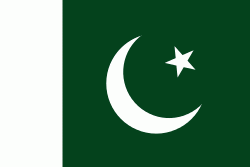Flag of Pakistan
The flag of Pakistan traces its current form back to a meeting of the Constituent Assembly of Pakistan on 11 August 1947, three days before the Partition of British India, when it was adopted by the All-India Muslim League as the official flag-to-be of the Dominion of Pakistan. It was retained upon the establishment of a constitution in 1956, and remains in use as the national flag for the present-day Islamic Republic of Pakistan. The flag is made up of a green field with a stylized tilted white crescent moon and five-pointed star at its centre, and a vertical white stripe at its hoist-end. Though the specific shade of green on the flag is mandated only as 'dark green', its official and most consistent representation is in Pakistan green, which is shaded distinctively darker.
Most notably, the flag is referred to in the third verse of Pakistan's national anthem, and is widely flown on several important days of the year, including Republic Day, Independence Day and Defence Day. It is also hoisted every morning at schools, offices and government buildings to the playing of the national anthem and lowered again before sunset. A very elaborate flag-raising and lowering ceremony is carried out every evening by the Pakistan Rangers and their Indian Border Security Force counterparts at the Wagah–Attari border crossing between India and Pakistan, which is regularly attended by hundreds of spectators. The Government of Pakistan has formalized rules and regulations related to the flying of the national flag; it is to be displayed all day at full-mast on 23 March annually to commemorate the adoption of the Lahore Resolution in 1940 and the declaration of Pakistan as an independent Islamic republic with a constitution in 1956, both of which occurred on the same day. The same regulations also apply on 14 August annually, in celebration of Pakistan's day of independence; when the country was carved out from erstwhile British India as the homeland and nation-state for the Muslims of the Indian subcontinental.
In 1947, the Viceroy of India, Louis Mountbatten, proposed a national flag for the state of Pakistan which comprised the flag of the All-India Muslim League albeit with a Union Jack in the canton. This proposal was rejected by Muhammad Ali Jinnah on the grounds that a flag featuring both Saint George's Christian Cross alongside an Islamic star and crescent would not be accepted by the Pakistani people.
Most notably, the flag is referred to in the third verse of Pakistan's national anthem, and is widely flown on several important days of the year, including Republic Day, Independence Day and Defence Day. It is also hoisted every morning at schools, offices and government buildings to the playing of the national anthem and lowered again before sunset. A very elaborate flag-raising and lowering ceremony is carried out every evening by the Pakistan Rangers and their Indian Border Security Force counterparts at the Wagah–Attari border crossing between India and Pakistan, which is regularly attended by hundreds of spectators. The Government of Pakistan has formalized rules and regulations related to the flying of the national flag; it is to be displayed all day at full-mast on 23 March annually to commemorate the adoption of the Lahore Resolution in 1940 and the declaration of Pakistan as an independent Islamic republic with a constitution in 1956, both of which occurred on the same day. The same regulations also apply on 14 August annually, in celebration of Pakistan's day of independence; when the country was carved out from erstwhile British India as the homeland and nation-state for the Muslims of the Indian subcontinental.
In 1947, the Viceroy of India, Louis Mountbatten, proposed a national flag for the state of Pakistan which comprised the flag of the All-India Muslim League albeit with a Union Jack in the canton. This proposal was rejected by Muhammad Ali Jinnah on the grounds that a flag featuring both Saint George's Christian Cross alongside an Islamic star and crescent would not be accepted by the Pakistani people.
National flag
Country - Pakistan
Warning: getimagesize(/Image/Map/MP1168579.gif): failed to open stream: No such file or directory in /home/mapnlee7/public_html/MAPNALL/article.php on line 532
 |
 |
Pakistan is the site of several ancient cultures, including the 8,500-year-old Neolithic site of Mehrgarh in Balochistan, the Indus Valley civilisation of the Bronze Age, the most extensive of the civilisations of the Afro-Eurasia, and the ancient Gandhara civilization. The region that comprises the modern state of Pakistan was the realm of multiple empires and dynasties, including the Achaemenid; briefly that of Alexander the Great; the Seleucid, the Maurya, the Kushan, the Gupta; the Umayyad Caliphate in its southern regions, the Hindu Shahis, the Ghaznavids, the Delhi Sultanate, the Mughals, the Durranis, the Omani Empire, the Sikh Empire, British East India Company rule, and most recently, the British Indian Empire from 1858 to 1947.
